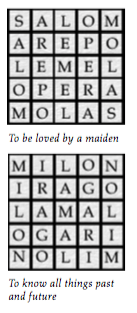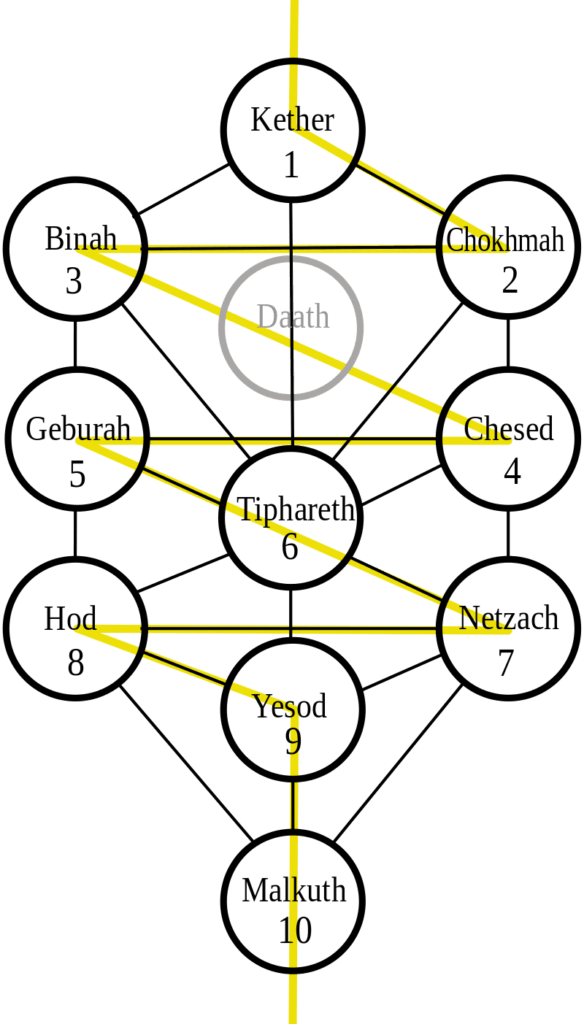Magick is quite simply, the art of working with energy. Either sending out energy to get your requests of love, money, health etc. answered as in spells or rituals or to sense energy coming in through your psychic senses of feeling, knowing, seeing or hearing.
Magick can easily be seen or felt in your life through paying attention to the things or signs that happen in your life. For example, If you are looking for love and you do a ritual or spell for love and then at work there is new person who just got hired and is introduced to you, then this is a sign. Every person you talk to, every place you go, everything you do is a sign for one thing or another so pay attention to these things in your life as these are doors opening in your world.
In order to send out stronger Magick you need to be able to focus your attention. Keeping the chatter mind or conscious mind quiet for even a few minutes and focusing takes lots of practice but will produce powerful Magickal results in your life.
In today’s world, black magick or malicious magic, practitioners are typically shunned by society and/or forbidden by law, as well as hated and feared by the general populace. White magick or (beneficial magic) is tolerated or even accepted by the people.
I will say, there is no discredit to those who call themselves “white witches” and their is no truth to the popular idea of “black magic” is stronger. The power of a witch is in his/her practice and skill mastery. For example a white magic spell for protection may kill one practicing black magic should they be unknowledgeable about the art of protection. Everyone has the right to practice as they desire.
Though magic itself is neutral, practitioners often distinguish between good, or white magic and bad, or black magic—though such distinctions are subjective. Bardon divided magic into three types:
-
Lower magic, which deals with the laws of nature and control of forces in nature, such as the ELEMENTS
-
Intermediate magic, which deals with the laws of human beings in the microcosm, and how the microcosm can be influenced
-
Higher magic, which deals with the universal laws of the macrocosm and how they can be controlled

Source:
Bardon, Franz. Initiation into Hermetics: A Course of Instruction of Magic Theory and Practice. Wuppertal, Germany: Dieter Ruggeberg, 1971.
What is Low V High Magick?
Low Magick
Low magic, sometimes called natural magic, was widely practiced in the Middle Ages and still is in some parts of the world. Also known as practical magic, it combines the arts of chaos, witchcraft, spell craft, hex craft, hoodoo,candle magick, and voodoo, which utilize herbs, amulets, wax images and other simple objects along with visualization and incantations to bring about the desired result.
It is the folk magic of less developed parts of the world where it is often done for a fee, and in the developed world it is the magic of many spell casters. In low magic, spells are cast for “good” or “evil”.
For most part, low magic does not follow a strict system of ritual or correspondences. The practitioner has the ability to vary the ritual or spell according to their own desires (for most part.)
High Magick
High magic, or Ceremonial Magick, the powers of nature, conceived of as being either angelic or Satanic, are controlled in conjunction with spirits, using words and the names of sacred gods. Typically, magic involves the use of elaborate rituals, the invocation of spirits (often in dramatic, theatrical fashion) and mystic sacraments.
Practiced since ancient times, Ceremonial Magic is mainly the domain of women and men seeking mystical power and enlightenment.
Ceremonial Magic is still practiced by those who adhere to Abramelin magic and the Kabbalah; Thelema; and other such grimoires.

Involving spirit communication, word magic and palindromic number squares, Abramelin magicians believe that the world was created and is maintained by demons whose work is directed by angelic spirits. The magicians believe that properly purified and using the correct prayers, formulas and tools, and with the help of the angels they can take control of the demons and bend them to their will.
Black Magic Practices, could be seen as either high or low magic, depending on the style of magic performed, and the type of spirit contacted.
Kabbalah
We have provided knowledge about the Kabbalah on our website, as we have spell casters, who also use this style of magic for our clients and for ourselves. Click here to read more about the Kabbalah
The Kabbalah is based on unusual interpretations of the Hebrew scriptures. Despite its appearance as an elaborate system of magic, it is actually a tool to allow the magician to achieve mystical union with God.
The Kabbalah teaches that God is known by 72 different names and that the Universe is composed of four planes of being.
The Tree of Life is a tool used to categorize and organize various mystical concepts. At its most simple level, it is composed of ten spheres, or emanations, called sephiroth (sing. “sephira”) which are connected by twenty two paths. The sephiroth are represented by the planets and the paths by the characters of the Hebrew alphabet, which are subdivided by the four classical elements, the seven classical planets, and the twelve signs of the Zodiac. Within the western magical tradition, the Tree is used as a kind of conceptual filing cabinet. Each sephira and path is assigned various ideas, such as gods, cards of the Tarot, astrological planets and signs, elements, etc.

Crowley considered a deep understanding of the Tree of Life to be essential to the magician:
The Tree of Life has got to be learnt by heart; you must know it backwards, forwards, sideways, and upside down; it must become the automatic background of all your thinking. You must keep on hanging everything that comes your way upon its proper bough.[
It also plays an important role in modeling the spiritual journey, where the adept begins in Malkuth, which is the every-day material world of phenomena, with the ultimate goal being at Kether, the sphere of Unity with the All.
There are several facets of the Kabbalah that make it compatible with the beliefs and practices of nature-orientated Pagans and Wiccans, but most Pagans would find the monotheism and strict codes of behavior imposed by Judaism, with which the Kabbalah is inextricably linked, hard to accept.
Thelema
Magick, in the context of Aleister Crowley’s Thelema, is a term used to show and differentiate the occult (or LHP), from performance magic and is defined as “the Science and Art of causing Change to occur in conformity with Will”, including both “mundane” acts of will as well as ritual magic.
One must find out for oneself, and make sure beyond doubt, who one is, what one is, why one is …Being thus conscious of the proper course to pursue, the next thing is to understand the conditions necessary to following it out. After that, one must eliminate from oneself every element alien or hostile to success, and develop those parts of oneself which are specially needed to control the aforesaid conditions. (Crowley, Magick, Book 4 p.134)
There are several ways to view what Magick is. Again, at its most broad, it can be defined as any willed action leading to intended change. It can also be seen as the general set of methods used to accomplish the Great Work of mystical attainment.
At the practical level, Magick most often takes several practices and forms of ritual, including banishing, invocation and evocation, eucharistic ritual, consecration and purification, astral travel, yoga, sex magic, and divination.
Vibration of god-names
In magical rituals involving the invocation of deities, a vocal technique called vibration is commonly used. This was a basic aspect of magical training for Crowley, who described it in “Liber O.”
According to that text, vibration involves a physical set of steps, starting in a standing position, breathing in through the nose while imagining the name of the god entering with the breath, imagining that breath traveling through the entire body, stepping forward with the left foot while throwing the body forward with arms outstretched, visualizing the name rushing out when spoken, ending in an upright stance, with the right forefinger placed upon the lips.
According to Crowley in “Liber O”, success in this technique is signaled by physical exhaustion and “though only by the student himself is it perceived, when he hears the name of the God vehemently roared forth, as if by the concourse of ten thousand thunders; and it should appear to him as if that Great Voice proceeded from the Universe, and not from himself.”
In general ritual practice, vibration can also refer to a technique of saying a god-name or a magical formula in a long, drawn-out fashion (i.e. with a full, deep breath) that employs the nasal passages, such that the sound feels and sounds “vibrated’. This is known as Galdering.
Magical Words
A magical formula is generally a name, word, or series of letters whose meaning illustrates principles and degrees of understanding that are often difficult to relay using other forms of speech or writing. It is a concise means to communicate very abstract information through the medium of a word or phrase, usually regarding a process of spiritual or mystical change. Common formulae include INRI, IAO, ShT, AUMGN, NOX, and LVX.
These words often have no intrinsic meaning in and of themselves. However, when deconstructed, each individual letter may refer to some universal concept found in the system that the formula appears. Additionally, in grouping certain letters together one is able to display meaningful sequences that are considered to be of value to the spiritual system that utilizes them (e.g. spiritual hierarchies, historiographic data, psychological stages, etc.)
Magical Weapons
A magical weapon is any instrument used to bring about intentional change. As Crowley writes, “Illustration: It is my Will to inform the World of certain facts within my knowledge. I therefore take “magical weapons”, pen, ink, and paper … The composition and distribution of this book is thus an act of Magick by which I cause Changes to take place in conformity with my Will.”
With that said, in practice, magical weapons are usually specific, consecrated items used within ceremonial magic. There is no hard and fast rule for what is or isn’t a magical weapon—if a magician considers it such a weapon, then it is. However, there does exist a set of magical weapons that have particular uses and symbolic meanings. Common weapons include the dagger (or athame in neopagan parlance), sword, wand, holy oil, cup (or graal), disk (or pentacle), oil lamp, bell, and thurible (or censer).
References:
- https://en.wikipedia.org/wiki/Tree_of_life_(Kabbalah)
- https://en.wikipedia.org/wiki/Magick_(Thelema)
- https://en.wikipedia.org/wiki/Chaos_magic
